Antec EDGE 550W Power Supply Review
by E. Fylladitakis on October 3, 2014 10:00 AM EST- Posted in
- Cases/Cooling/PSUs
- Antec
- 550W
- Edge
Hot Test Results
The tables below show that the Antec EDGE 550W has very good, albeit strange, electrical performance. It has excellent voltage regulation, maintaining all voltage lines between 1.7-2% across the load range. The filtering is where things get a bit peculiar.
The EDGE 550W has exceptional filtering on the 12V line, with our instrumentation displaying a maximum voltage ripple of just 38mV; however, the filtering of the 5V line is mediocre, reaching 38mV as well, which is nearly 80% of the 5V line design limit. The filtering of the 3.3V is excellent as well, with the ripple peaking at just 20mV under maximum load. As the 5V line is being derived by a DC-to-DC conversion circuit similar to that of the 3.3V line, we investigated this result extensively and even searched the parts for a malfunctioning component, but nothing was found to be problematic. It appears that the filtering of the 5V line (at least on the sample we received) is rather weak.
| Main Output | ||||||||
| Load (Watts) | 111.69 W | 278.11 W | 412.77 W | 548.36 W | ||||
| Load (Percent) | 20.31% | 50.57% | 75.05% | 99.7% | ||||
| Line | Amperes | Volts | Amperes | Volts | Amperes | Volts | Amperes | Volts |
| 3.3 V | 3.12 | 3.37 | 7.79 | 3.36 | 11.69 | 3.32 | 15.58 | 3.31 |
| 5 V | 3.12 | 5.04 | 7.79 | 5 | 11.69 | 4.98 | 15.58 | 4.95 |
| 12 V | 7.01 | 12.19 | 17.53 | 12.15 | 26.29 | 12.01 | 35.06 | 11.97 |
| Line |
Regulation (20% to 100% load) |
Voltage Ripple (mV) | |||||
| 20% Load | 50% Load | 75% Load | 100% Load |
CL1 12V |
CL2 3.3V + 5V |
||
| 3.3V | 1.7% | 10 | 14 | 16 | 20 | 8 | 16 |
| 5V | 2% | 12 | 20 | 28 | 38 | 12 | 42 |
| 12V | 1.8% | 16 | 24 | 30 | 38 | 40 | 18 |
Aided by its low thermal losses and internal temperatures, it appears that a high ambient temperature hardly affects the performance of the Antec EDGE 550W unit. The reduction of the average nominal load (20-100%) efficiency is minimal, just 0.4%, while the maximum efficiency is 92.1% at 50% load. With these performance figures, the Antec EDGE 550W could receive its 80Plus Gold certification even under this much higher ambient temperature.
The high ambient temperature naturally affects the behavior of the cooling system and the acoustic performance of the unit. However, due to the low output of the unit, the temperature of the heatsinks still remains relatively low. As such, the Antec EDGE 550W does not really need to make its fan spin faster in order to maintain safe operating temperatures. The only difference is that the fan increases its speed further while the unit is under maximum load, but the higher SPL hardly makes a change that would be easily noticeable by a person's ear.


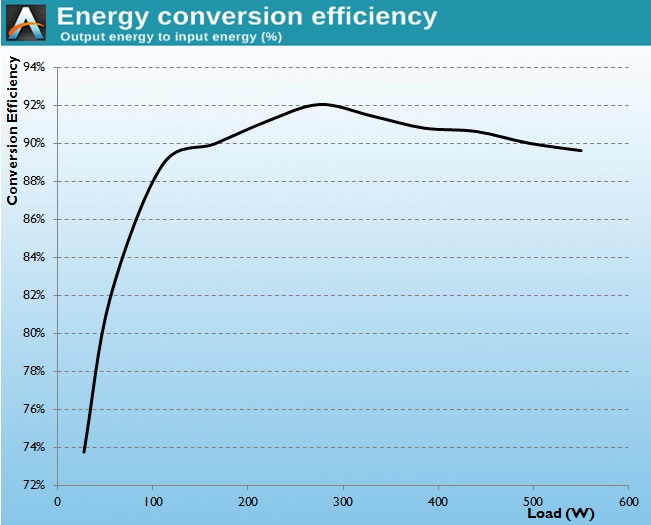
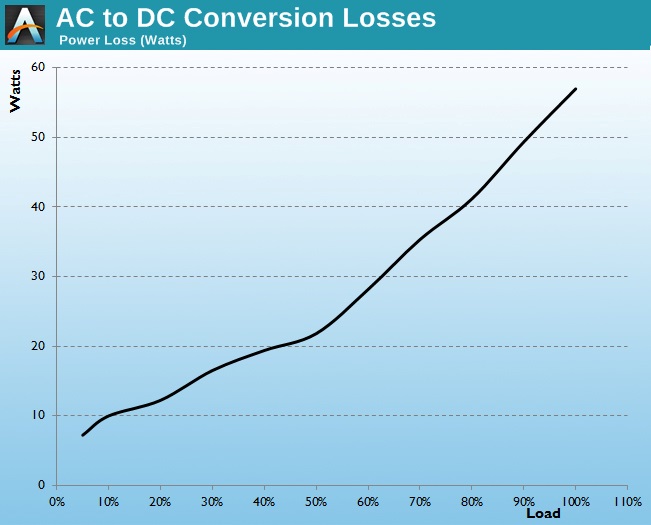
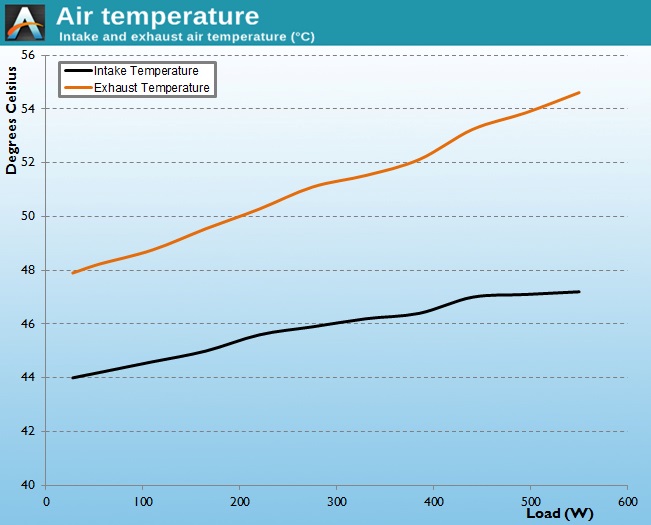
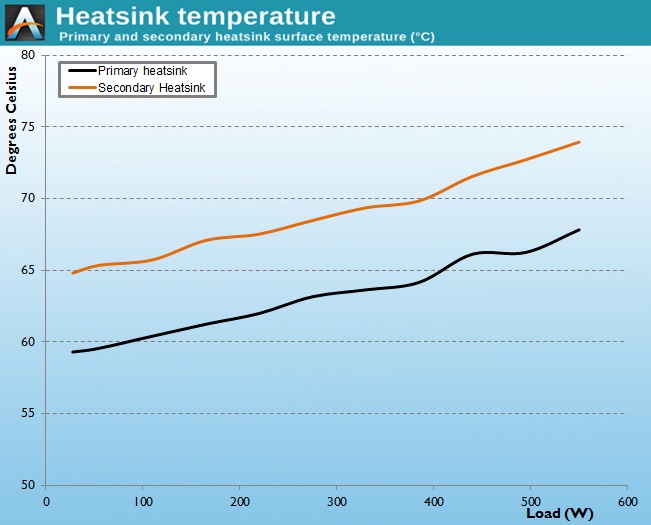
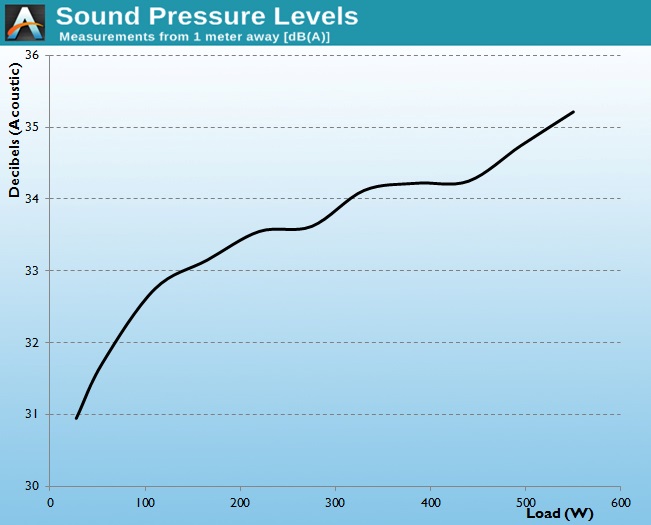








25 Comments
View All Comments
mindbomb - Friday, October 3, 2014 - link
This seems like a pretty good psu. Should be enough for an i7 5820k and single gtx 980, with plenty of room left for overclocking.just4U - Friday, October 3, 2014 - link
The very first thing I look for in power supply reviews is which company is the manufacturer. Some you trust, some your iffy about and others you simply try to avoid. It's sometimes very hard to get that information and companies tend to jump from one manufacturer to the next in the middle of a products life cycle which makes it even harder.I am very pleased to see Antec (and Cooler Master come to think of it..) partnering up with Seasonic. It means I will be buying a lot more of their Power Supplies. I am also pleased to see Antect paying more attention to their cabling. It's always been a bone of contention for me and fully sleeved cables with no multi colored wires is always a plus.
Since I am pretty confident that someone at Antec will read this.. You dropped the ball on a lot of your casing designs of late. The Sonata needs a overhaul and the Lanboy should be a top seller if it's based on it's old Super Lan boy Aluminum design with slight modifications to factor in new cooling and cable management. ( a Removable MB Tray would be nice for enthusiasts to..) It's really not rocket science to figure out.
Take the Sonata redesign Throw in a power supply like this one and you got a win/win. The Sonata was billed as quiet but yeah.. no it wasn't still it's a popular casing that does need a minor refresh as well..
Anyway E. Great review.
Alexvrb - Friday, October 3, 2014 - link
I've got a Solo II (part of their Sonata lineup) that's pretty quiet, and has excellent build quality. The HDD suspension system is nice too, as is the SSD mount location. It's probably one of the shortest cases that supports full ATX boards and large graphics cards without major flaws or an insane price tag. With that being said I do feel they could improve on it a bit. But for its size they did quite well.Alan G - Friday, October 3, 2014 - link
So I can get a Seasonic G550 for about $40 less than this Antec/Seasonic PSU. I also get the same 5 year warranty on the unit and it's Gold plus certified. How do Antec expect to sell their branded Seasonic PSU?Daniel Egger - Friday, October 3, 2014 - link
It's good to see the reviews finally moving from insanely crazy to regular overkill but 550W is still way out of range of what an average user needs and that's even including a heavy duty graphics card, for those 350W are more than plenty. For "average" by that definition I'd like to see a review of a Seasonic X-400FL Platinum or a similarly good performer. The only point I can see in going for overkill is the better optimum efficiency at medium loads and quite frankly the Antec is simply not that good at this rating and price point...CknSalad - Friday, October 3, 2014 - link
Antec only makes good PSUs now and even then they can be quite expensive compared to the competition (even SeaSonic). I remember back when Antec was the brand for computer cases with their 900, 300, and sonata series. It's sad to see a once big-name company like Antec be a shadow of their former selves.romrunning - Friday, October 3, 2014 - link
Thanks for giving us a review on a lower-rated (less than 1kW) power supply! I really appreciate it - these are what I use when building my mini-ITX cases! Well, I also use SFX PSUs like the one Silverstone supplies.I would also love to see a test of some common GPUs (single, not SLI/Crossfire configs), Intel i5-i7s, and what is really needed to power such "common" systems.
romrunning - Friday, October 3, 2014 - link
Also, thanks for calling out the price. $120 is a bit steep for a budget/mainstream gaming build.Daniel Egger - Friday, October 3, 2014 - link
H81/87, Core-i5/7-4xxxS, SSD and GTX 750 Ti OC, BD-ROM are (at the wall) < 30W idle and around 130W if you throw FurMark and wPrime at it; that's already after the loss of the power conversion. You do the math...bsim500 - Saturday, October 4, 2014 - link
"I would also love to see a test of some common GPUs (single, not SLI/Crossfire configs), Intel i5-i7s, and what is really needed to power such "common" systems."As Daniel Egger said - far less than most people think. I have an i5-3570, even OC'd to 4GHz under Prime doesn't break the 100w barrier. Idle's at 37w (with discrete GPU which falls to 26w iGPU only), and it's not even a Haswell. Throw in an efficient nVidia Maxwell based GFX card (eg, 750Ti) and run Prime + Furmark and you're still under 150w under unrealistic synthetic "double power virus" conditions. For most normal gaming, it's nearer 80-120w (for a rig that can run most games at 1080p on console equivalent "Medium" setting) and wouldn't even use 50% capacity of a Seasonic G360. For high end gaming rigs, even a new GTX 970 would remain under 300w (maybe nearer 250w if you undervolted it a little) and easily function off of a decent 500-550w PSU at 50-60% PSU capacity.
For non gaming rigs, it's more like 40-70w just browsing the web & using office, 100w max full video encoding, etc, and that could easily run off a Pico-PSU laptop style power brick. All above figures on my rigs are measured at the wall with a kill-a-watt on Gold rated Seasonics, not merely 'calculated' from TDP, etc.